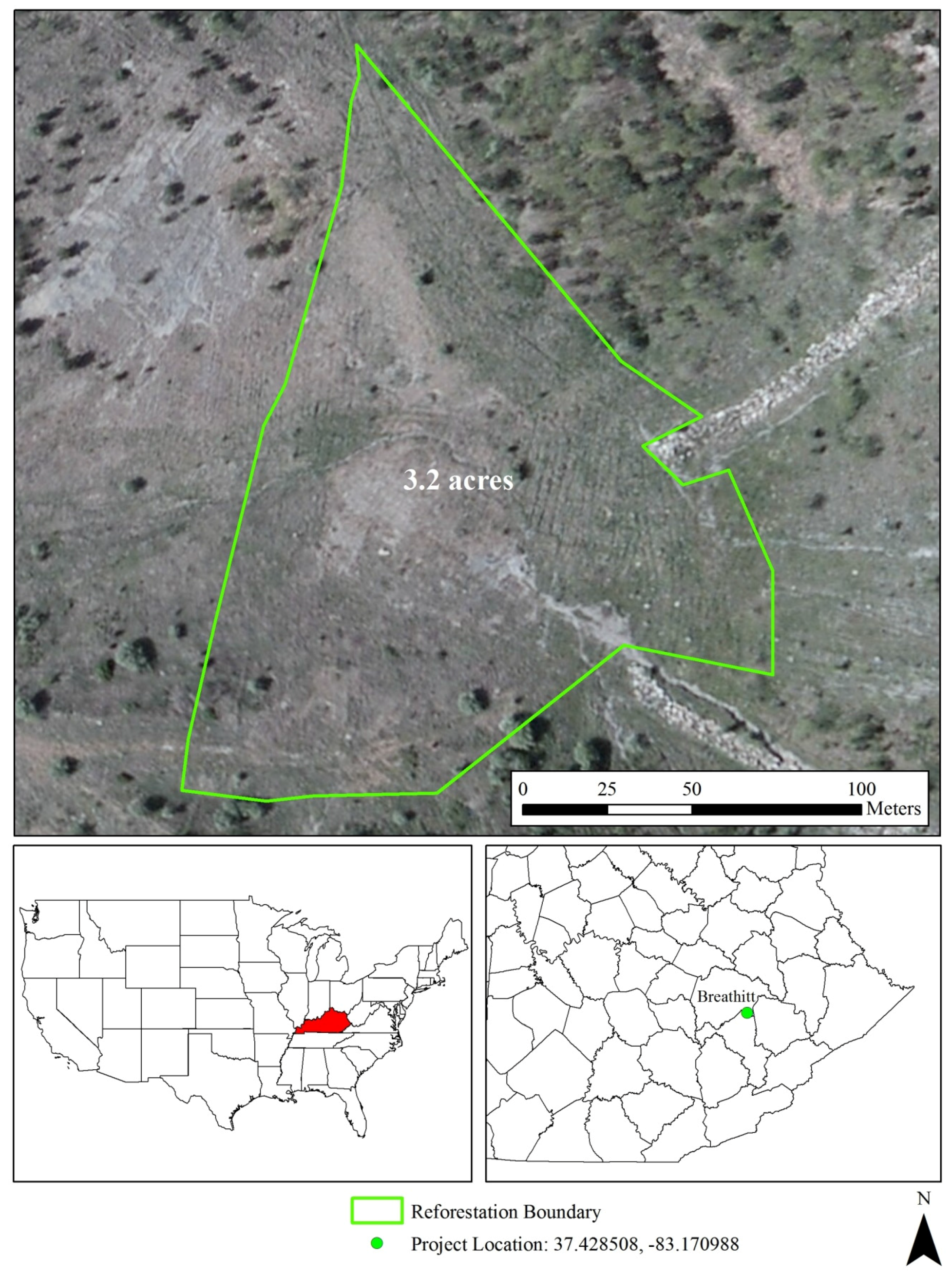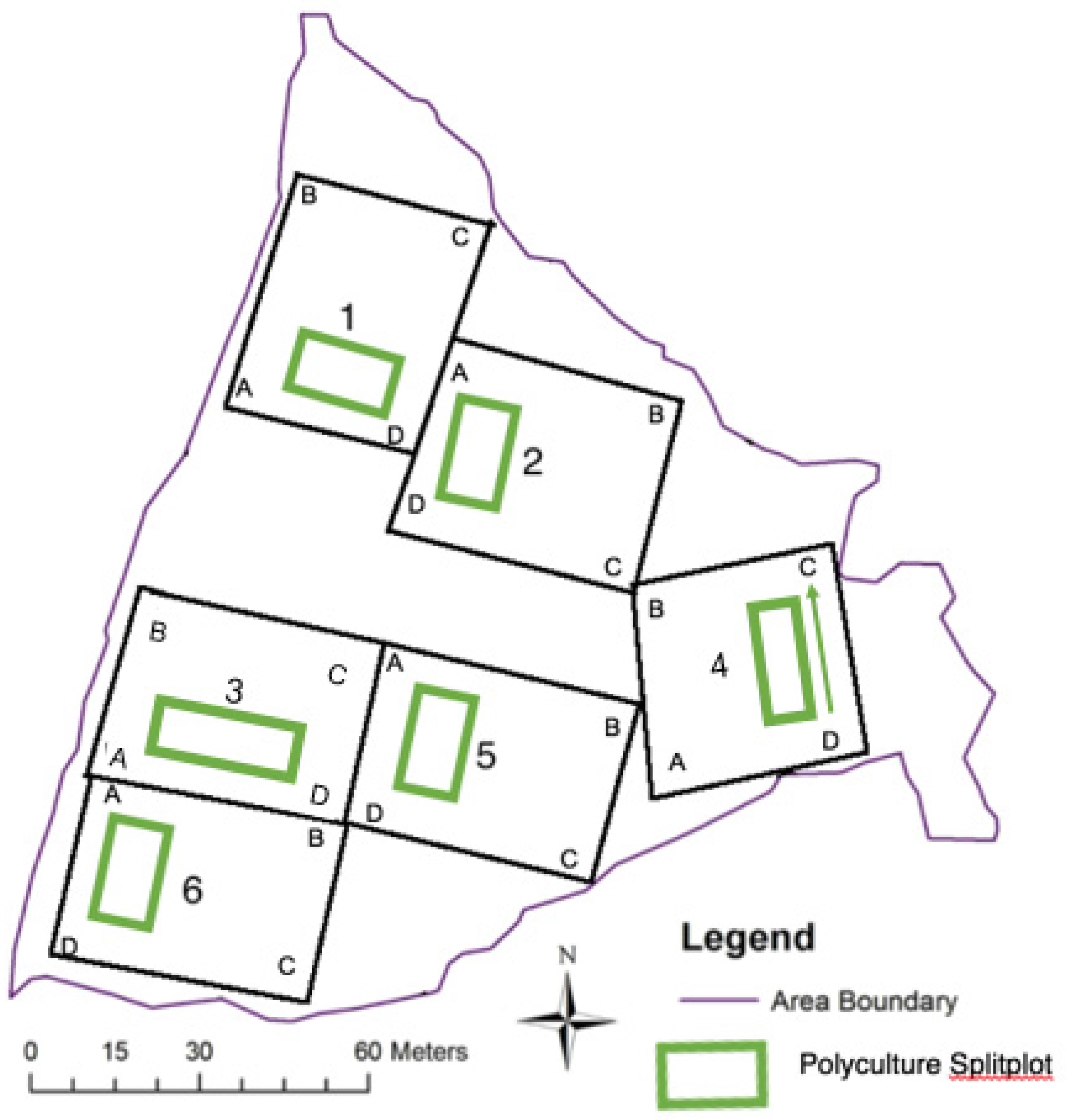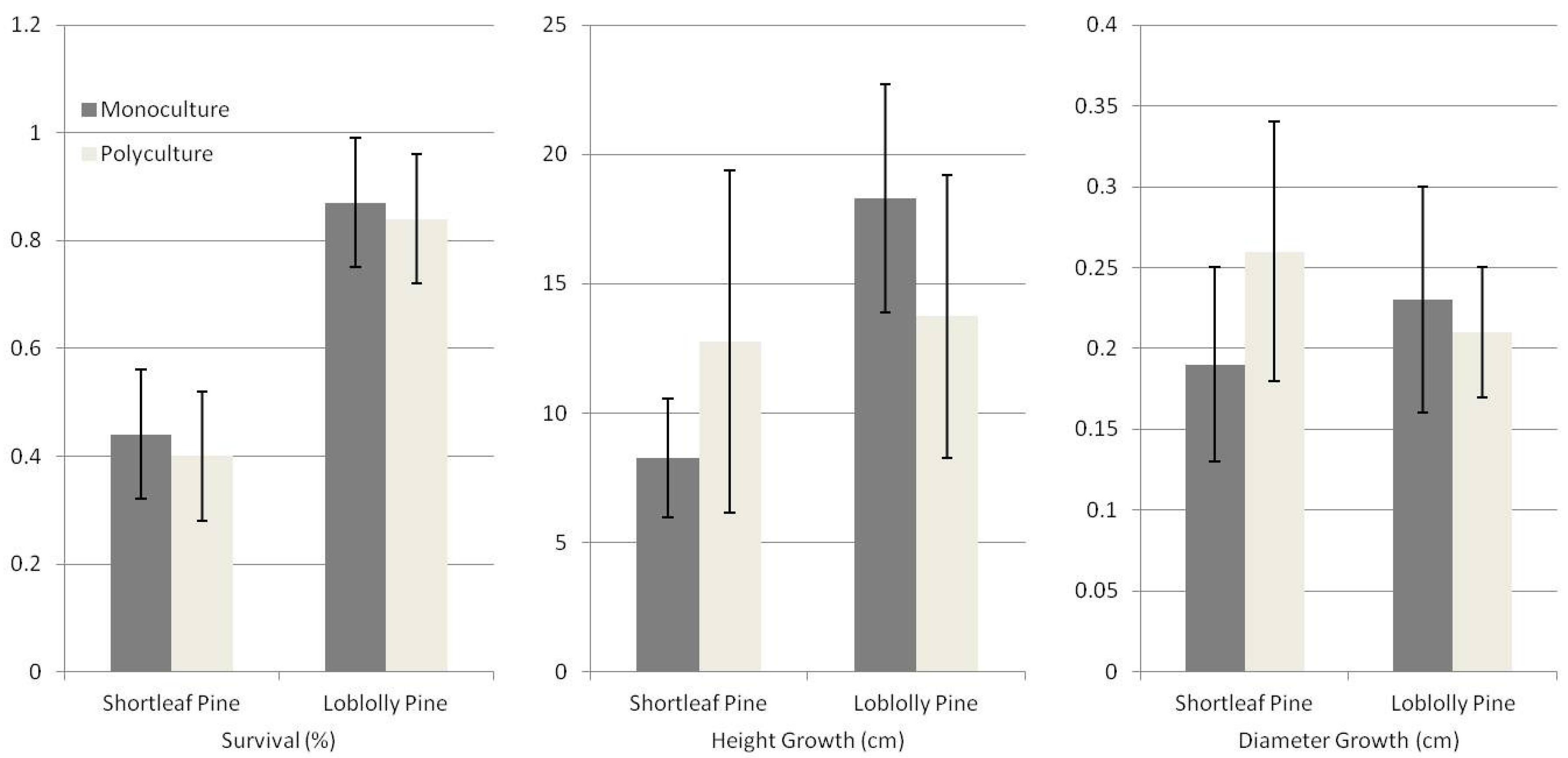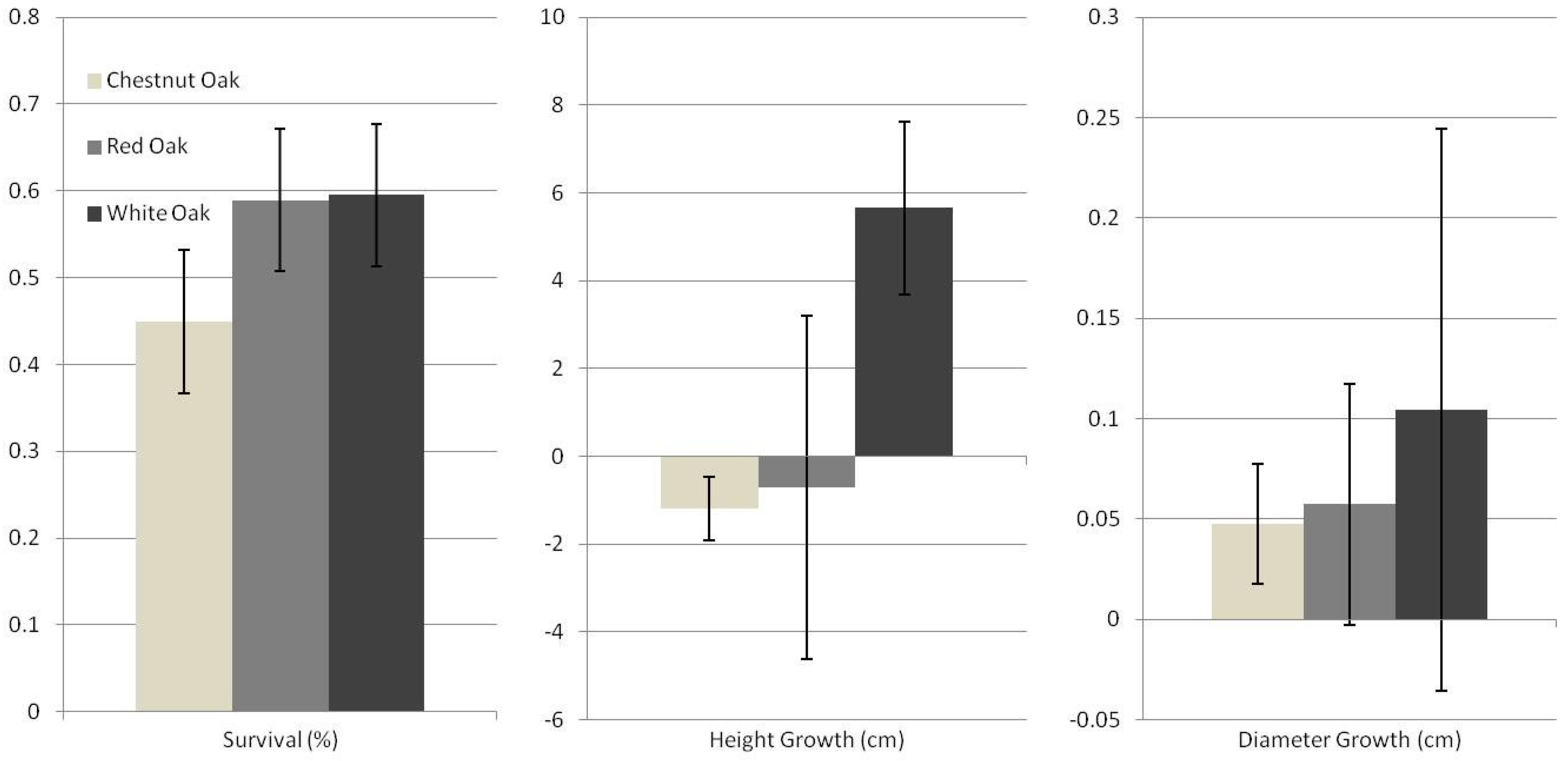Establishing Pine Monocultures and Mixed Pine-Hardwood Stands on Reclaimed Surface Mined Land in Eastern Kentucky: Implications for Forest Resilience in a Changing Climate
Abstract
:1. Introduction:
1.1. Surface Mine Reclamation and Reforestation
1.2. Shortleaf Pine Restoration
2. Methods and Materials
2.1. Plot Establishment and Data Collection
2.2. Statistical Methods
3. Results
4. Discussion
Acknowledgments
Author Contributions
Conflicts of Interest
References
- Haering, K.C.; Daniels, W.L.; Galbraith, J.M. Appalachian mine soil morphology and properties: Effects of weathering and mining method. Soil Sci. Soc. Am. J. 2004, 68, 1315–1325. [Google Scholar] [CrossRef]
- Zipper, C.E.; Burger, J.A.; McGrath, J.M.; Rodrigue, J.A.; Holtzman, G.I. Forest restoration potentials of coal-mined lands in the eastern United States. J. Environ. Qual. 2011, 40, 1567–1577. [Google Scholar] [CrossRef] [PubMed]
- Wickham, J.; Wood, P.B.; Nicholson, M.C.; Jenkins, W.; Druckenbrod, D.; Suter, G.W.; Strager, M.P.; Mazzarella, C.; Galloway, W.; Amos, J. The overlooked terrestrial impacts of mountaintop mining. Bioscience 2013, 63, 335–348. [Google Scholar] [CrossRef]
- Zipper, C.E.; Burger, J.A.; Skousen, J.G.; Angel, P.N.; Barton, C.D.; Davis, V.; Franklin, J.A. Restoring forests and associated ecosystem services on Appalachian coal surface mines. Environ. Manag. 2011, 47, 751–765. [Google Scholar] [CrossRef] [PubMed]
- Davis, V.; Burger, J.A.; Rathfon, R.; Zipper, C.E.; Miller, C.R. Chapter 7: Selecting Tree Species for Reforestation of Appalachian Mined Lands. In The Forestry Reclamation Approach: Guide to Successful Reforestation of Mined Lands; Adams, M.B., Ed.; Gen. Tech. Rep. NRS-169; U.S. Department of Agriculture, Forest Service, Northern Research Station: Newtown Square, PA, USA, 2017; pp. 7-1–7-10. [Google Scholar]
- Sena, K.; Barton, C.; Hall, S.; Angel, P.; Agouridis, C.; Warner, R. Influence of spoil type on afforestation success and natural vegetative recolonization on a surface coal mine in Appalachia, United States. Restor. Ecol. 2015, 23, 131–138. [Google Scholar] [CrossRef]
- Wilson-Kokes, L.; Emerson, P.; DeLong, C.; Thomas, C.; Skousen, J. Hardwood tree growth after eight years on brown and gray mine soils in West Virginia. J. Environ. Qual. 2013, 42, 1353–1362. [Google Scholar] [CrossRef] [PubMed]
- Cotton, C.; Barton, C.; Lhotka, J.; Angel, P.N.; Graves, D. Evaluating reforestation success on a surface mine in eastern Kentucky. In Tech. Coords. National Proceedings: Forest and Conservation Nursery Associations-2011; USDA Forest Service, Rocky Mountain Research Station: Fort Collins, CO, USA, 2012; pp. 16–23. [Google Scholar]
- Sena, K.; Angel, H.; Barton, C. Influence of tree shelters and weed mats on growth and survival of backcrossed chestnut seedlings on legacy minelands in eastern Kentucky. J. Am. Soc. Min. Reclam. 2014, 3, 41–63. [Google Scholar] [CrossRef]
- Fields-Johnson, C.W.; Burger, J.A.; Evans, D.M.; Zipper, C.E. Ripping improves tree survival and growth on unused reclaimed mined lands. Environ. Manag. 2014, 53, 1059–1065. [Google Scholar] [CrossRef] [PubMed]
- Skousen, J.; Gorman, J.; Pena-Yewtukhiw, E.; King, J.; Stewart, J.; Emerson, P.; Delong, C. Hardwood tree survival in heavy ground cover on reclaimed land in West Virginia: Mowing and ripping effects. J. Environ. Qual. 2009, 38, 1400–1409. [Google Scholar] [CrossRef] [PubMed]
- Barton, C.D.; Sweigard, R.J.; Marx, D.; Barton, W. Evaluating spoil amendment use and mycorrhizal inoculation on reforestation success in the eastern and western Kentucky coalfields. In Proceedings of the American Society of Mining and Reclamation, Richmond, VA, USA, 14–19 June 2008; Barnhisel, R.I., Ed.; pp. 98–111. [Google Scholar]
- Hansen, E.; Barton, C.; Drayer, A. Challenges for native forest establishment on surface mines in a time of climate change. Reclam. Matters 2015, Spring, 36–39. [Google Scholar]
- Will, R.; Stewart, J.; Lynch, T.; Turton, D.; Maggard, A.; Lilly, C.; Atkinson, K. Strategic Assessment for Shortleaf Pine; Oklahamoa Forestry Services: Washington, OK, USA, 2013; p. 58. [Google Scholar]
- Oswalt, C.M. Spatial and Temporal Trends of the Shortleaf Pine Resource in the Eastern United States. In Proceedings of the Shortleaf Pine Conference, East Meets West, Huntsville, AL, USA, 20–22 September 2011; Kush, J., Barlow, R.J., Gilbert, J.C., Eds.; 2012; p. 33. [Google Scholar]
- Campbell, W.A.; Copeland, J.O.L. Littleleaf Diseases of Shortleaf and Loblolly Pines; USDA Circular No. 940; USDA: Washington, DC, USA, 1954; Volume 41.
- Clarke, S.R.; Riggins, J.J.; Stephen, F.M. Forest management and southern pine beetle outbreaks: A historical perspective. For. Sci. 2016, 62, 166–180. [Google Scholar] [CrossRef]
- Coyle, D.R.; Klepzig, K.D.; Koch, F.H.; Morris, L.A.; Nowak, J.T.; Oak, S.W.; Otrosina, W.J.; Smith, W.D.; Gandhi, K.J. A review of southern pine decline in North America. For. Ecol. Manag. 2015, 349, 134–148. [Google Scholar] [CrossRef]
- Coyle, D.R.; Green, G.T.; Barnes, B.F.; Klepzig, K.D.; Nowak, J.T.; Gandhi, K.J. Landowner and manager awareness and perceptions of pine health issues and southern pine management activities in the southeastern United States. J. For. 2016, 114, 541–551. [Google Scholar] [CrossRef]
- Liechty, H.O.; Luckow, K.R.; Daniel, J.S.; Marion, D.A.; Spetich, M.; Guldin, J.M. Shortleaf pine ecosystem restoration: Impacts on soils and woody debris in the Ouachita Mountains of the southern United States. In Proceedings of the 16th International Conference, Society for Ecological Restoration, Victoria, BC, Canada, 24–26 August 2004; p. 5. [Google Scholar]
- Stewart, J.F.; Will, R.E.; Crane, B.S.; Nelson, C.D. The genetics of shortleaf pine (Pinus echinata mill.) with implications for restoration and management. Tree Genet. Genom. 2016, 12, 98. [Google Scholar] [CrossRef]
- Liechty, H.O.; Luckow, K.R.; Guldin, J.M. Soil chemistry and nutrient regimes following 17–21 years of shortleaf pine-bluestem restoration in the Ouachita Mountains of Arkansas. For. Ecol. Manag. 2005, 204, 345–357. [Google Scholar] [CrossRef]
- Hubbard, R.M.; Vose, J.M.; Clinton, B.D.; Elliott, K.J.; Knoepp, J.D. Stand restoration burning in oak–pine forests in the southern Appalachians: Effects on aboveground biomass and carbon and nitrogen cycling. For. Ecol. Manag. 2004, 190, 311–321. [Google Scholar] [CrossRef]
- Perry, R.W.; Rudolph, D.C.; Thill, R.E. Reptile and amphibian responses to restoration of fire-maintained pine woodlands. Restor. Ecol. 2009, 17, 917–927. [Google Scholar] [CrossRef]
- Thill, R.E.; Rudolph, D.C.; Koerth, N.E. Shortleaf pine-bluestem restoration for red-cockaded woodpeckers in the Ouachita Mountains: Implications for other taxa. In Red-Cockaded Woodpecker: Road to Recovery; Costa, R., Daniels, S.J., Eds.; Hancock House Publishers: Blaine, WA, USA, 2004; pp. 657–671. [Google Scholar]
- Conner, R.N.; Shackelford, C.E.; Schaefer, R.R.; Saenz, D.; Rudolph, D.C. Avian community response to southern pine ecosystem restoration for red-cockaded woodpeckers. Wilson Bull. 2002, 114, 324–332. [Google Scholar] [CrossRef]
- Masters, R.E.; Lochmiller, R.L.; McMurry, S.T.; Bukenhofer, G.A. Small mammal response to pine-grassland restoration for red-cockaded woodpeckers. Wildl. Soc. Bull. 1998, 148–158. [Google Scholar]
- O’Keefe, J.M.; Loeb, S.C. Indiana bats roost in ephemeral, fire-dependent pine snags in the southern Appalachian Mountains, USA. For. Ecol. Manag. 2017, 391, 264–274. [Google Scholar] [CrossRef]
- Cox, M.R.; Willcox, E.V.; Keyser, P.D.; Vander Yacht, A.L. Bat response to prescribed fire and overstory thinning in hardwood forest on the Cumberland Plateau, Tennessee. For. Ecol. Manag. 2016, 359, 221–231. [Google Scholar] [CrossRef]
- Burns, R.M.; Honkala, B.H. Tech. coords. 1990. Silvics of North America: 1. Conifers. In Agriculture Handbook 654; USDA Forest Service: Washington, DC, USA, 1990; Volume 1, p. 675. [Google Scholar]
- Pile, L.S.; Waldrop, T. Shortleaf Pine and Mixed Hardwood Stands: Thirty-Four Years after Regeneration with the Fell-and-Burn Technique in the Southern Appalachian Mountains; US Department of Agriculture Forest Service, Southern Research Station: Asheville, NC, USA, 2016; Volume SRS-56, pp. 1–7.
- Smalley, G.W.; Bower, D.R. Site Index Curves for Loblolly and Shortleaf Pine Plantations on Abandoned Fields in Tennessee, Alabama, and Georgia Highlands; USDA Forest Service, Southern Research Station: Asheville, NC, USA, 1971.
- Stambaugh, M.C.; Guyette, R.P.; Dey, D.C. What Fire Frequency Is Appropriate for Shortleaf Pine Regeneration and Survival? USDA Forest Service Northern Research Station: Newtown Square, PA, USA, 2007; Volume NRS-P-15, pp. 121–128.
- Stewart, J.F.; Will, R.E.; Robertson, K.M.; Nelson, C.D. Frequent fire protects shortleaf pine (Pinus echinata) from introgression by loblolly pine (P. taeda). Conserv. Genet. 2015, 16, 491–495. [Google Scholar] [CrossRef]
- Ashby, W.C.; Baker, M.B. Soil nutrients and tree growth under black locust and shortleaf pine overstories in strip-mine plantings. J. For. 1968, 66, 67–71. [Google Scholar]
- Walker, R.; West, D.; McLaughlin, S.; Amundsen, C. Performance of loblolly, virginia, and shortleaf pine on a reclaimed surface mine as affected by Pisolithus tinctorius ectomycorrhizae and fertilization. In Proceedings of the Biennial Southern Silvicultural Research Conference, Atlanta, GA, USA, 15–17 April 1985. [Google Scholar]
- Mattoon, W.R. Life History of Shortleaf Pine; US Department of Agriculture Bulletin 244; US Department of Agriculture: Washington, DC, USA, 1915.
- Butler, P.R.; Iverson, L.; Thompson, F.R.; Brandt, L.; Handler, S.; Janowiak, M.; Shannon, P.D.; Swanston, C.; Karriker, K.; Bartig, J. Central Appalachians Forest Ecosystem Vulnerability Assessment and Synthesis: A Report from the Central Appalachians Climate Change Response Framework Project; U.S. Department of Agriculture, Forest Service, Northern Research Station: Newtown Square, PA, USA, 2015.
- McNab, W.H.; Spetich, M.A.; Perry, R.W.; Haywood, J.D.; Laird, S.G.; Clark, S.L.; Hart, J.L.; Torreano, S.J.; Buchanan, M.L. Climate-induced migration of native tree populations and consequences for forest composition. In Climate Change Adaptation and Mitigation Management Options: A Guide for Natural Resource Managers in Southern Forest Ecosystems; CRC Press, Taylor & Francis Group: Boca Raton, FL, USA, 2014; pp. 307–378. [Google Scholar]
- Zolkos, S.G.; Jantz, P.; Cormier, T.; Iverson, L.R.; McKenney, D.W.; Goetz, S.J. Projected tree species redistribution under climate change: Implications for ecosystem vulnerability across protected areas in the eastern United States. Ecosystems 2015, 18, 202–220. [Google Scholar] [CrossRef]
- Miller, W.; Miller, D. A micro-pipette method for soil mechanical analysis. Commun. Soil Sci. Plant Anal. 1987, 18, 1–15. [Google Scholar] [CrossRef]
- Thomas, G. Soil ph and soil acidity. In Methods of Soil Analysis Part 3—Chemical Methods; Soil Science Society of America, American Society of Agronomy: Madison, WI, USA, 1996; pp. 475–490. [Google Scholar]
- Soil and Plant Analysis Council. Soil Analysis Handbook of Reference Methods; CRC Press: Boca Raton, FL, USA, 2000. [Google Scholar]
- Summer, M.E.; Miller, W.P. Cation exchange capacity and exchange coefficients. In Methods of Soil Analysis. Part 3. Chemical Methods; Sparks, D., Bartels, J.M., Eds.; Soil Science Society of America, American Society of Agronomy: Madison, WI, USA, 1996. [Google Scholar]
- Angel, P.; Barton, C.; Warner, R.; Agouridis, C.; Taylor, T.; Hall, S. Forest establishment and water quality characteristics as influenced by spoil type on a loose-graded surface mine in eastern Kentucky. In Proceedings of the American Society of Mining and Reclamation, Richmond, VA, USA, 14–19 June 2008; pp. 28–65. [Google Scholar]
- Fields-Johnson, C.W.; Zipper, C.E.; Burger, J.A.; Evans, D.M. First-year response of mixed hardwoods and improved american chestnuts to compaction and hydroseed treatments on reclaimed mine land. In Proceedings of the American Society of Mining and Reclamation, Billings, MT, USA, 30 May–5 June 2009; Barnhisel, R.I., Ed.; pp. 413–432. [Google Scholar]
- Koropchak, S.; Zipper, C.; Burger, J.; Evans, D. Native tree survival and herbaceous establishment on an experimentally reclaimed Appalachian coal mine. J. Am. Soc. Min. Reclam. 2013, 2, 32–55. [Google Scholar] [CrossRef]
- Dipesh, K.; Will, R.E.; Lynch, T.B.; Heinemann, R.; Holeman, R. Comparison of loblolly, shortleaf, and pitch x loblolly pine plantations growing in Oklahoma. For. Sci. 2015, 61, 540–547. [Google Scholar] [CrossRef]
- Michels, A.; Barton, C.; Cushing, T.; Angel, P.; Sweigard, R.; Graves, D. Evaluation of low spoil compaction techniques for hardwood forest establishment on an eastern Kentucky surface mine. In Proceedings of the American Society of Mining and Reclamation, Gillette, WY, USA, 2–6 June 2007; Barnhisel, R.I., Ed.; pp. 2–6. [Google Scholar]
- Stange, E.E.; Shea, K.L. Effects of deer browsing, fabric mats, and tree shelters on Quercus rubra seedlings. Restor. Ecol. 1998, 6, 29–34. [Google Scholar]
- Robertson, D.J. Trees, deer, and non-native vines: Two decades of northern piedmont forest restoration. Ecol. Restor. 2012, 30, 59–70. [Google Scholar] [CrossRef]
- Clark, E.V.; Zipper, C.E. Vegetation influences near-surface hydrological characteristics on a surface coal mine in eastern USA. Catena 2016, 139, 241–249. [Google Scholar] [CrossRef]
- Evans, D.M.; Zipper, C.E.; Hester, E.T.; Schoenholtz, S.H. Hydrologic effects of surface coal mining in Appalachia (US). J. Am. Water Resour. Assoc. 2015, 51, 1436–1452. [Google Scholar] [CrossRef]




| Year | Pine | Planting Mix | ||||
|---|---|---|---|---|---|---|
| 2016 | 2017 | Shortleaf Pine | Loblolly Pine | Monoculture | Polyculture | |
| Soil pH | 5.74b ± 0.31 | 6.18a ± 0.31 | 6.20 ± 0.42 | 5.72 ± 0.42 | 6.06 ± 0.42 | 5.86 ± 0.42 |
| P (mg/kg) | 6.92 ± 1.27 | 7.67 ± 1.27 | 6.79 ± 1.56 | 7.79 ± 1.56 | 7.83 ± 1.56 | 6.75 ± 1.56 |
| K (mg/kg) | 91.2 ± 6.24 | 78.6 ± 6.24 | 67.9b ± 6.58 | 101.9a ± 6.58 | 91.0 ± 6.58 | 78.8 ± 6.58 |
| Ca (mg/kg) | 996 ± 408 | 1409 ± 408 | 773 ± 529 | 1633 ± 529 | 1178 ± 529 | 1227 ± 529 |
| Mg (mg/kg) | 216.7 ± 16.5 | 206.1 ± 16.5 | 159.9b ± 22.4 | 262.9a ± 22.4 | 213.7 ± 22.4 | 209.1 ± 22.4 |
| Zn (mg/kg) | 3.09 ± 0.08 | 3.06 ± 0.08 | 2.28b ± 0.08 | 3.87a ± 0.08 | 3.39a ± 0.08 | 2.76b ± 0.08 |
| Total N (%) | - | - | 0.104b ± 0.014 | 0.196a ± 0.016 | 0.162 ± 0.023 | 0.138 ± 0.018 |
| Sand (%) | - | - | 62.7 ± 3 | 53.7 ± 4 | 58.0 ± 4 | 58.4 ± 4 |
| Silt (%) | - | - | 25.4 ± 2 | 32.7 ± 3 | 29.0 ± 3 | 29.0 ± 3 |
| Clay (%) | - | - | 12 ± 9 | 13.6 ± 1.2 | 12.9 ± 1.2 | 12.6 ± 0.9 |
| CEC (meq/100 g) | - | - | 7.46 ± 1.13 | 12.94 ± 1.20 | 10.84 ± 1.65 | 9.56 ± 1.13 |
| Exch K (meq/100 g) | - | - | 0.158 ± 0.02 | 0.308 ± 0.04 | 0.247 ± 0.04 | 0.219 ± 0.03 |
| Exch Ca (meq/100 g) | - | - | 3.58 ± 1.68 | 7.95 ± 2.09 | 6.63 ± 2.13 | 4.90 ± 1.85 |
| Exch Mg (meq/100 g) | - | - | 1.13b ± 0.16 | 2.26a ± 0.21 | 1.67 ± 0.23 | 1.72 ± 0.27 |
| Exch Na (meq/100 g) | - | - | 0.023 ± 0.004 | 0.026 ± 0.004 | 0.026 ± 0.005 | 0.023 ± 0.004 |
| Total C (%) | - | - | 0.022 ± 0.004 | 0.034 ± 0.002 | 0.029 ± 0.004 | 0.027 ± 0.003 |
© 2017 by the authors. Licensee MDPI, Basel, Switzerland. This article is an open access article distributed under the terms and conditions of the Creative Commons Attribution (CC BY) license (http://creativecommons.org/licenses/by/4.0/).
Share and Cite
Bell, G.; Sena, K.L.; Barton, C.D.; French, M. Establishing Pine Monocultures and Mixed Pine-Hardwood Stands on Reclaimed Surface Mined Land in Eastern Kentucky: Implications for Forest Resilience in a Changing Climate. Forests 2017, 8, 375. https://doi.org/10.3390/f8100375
Bell G, Sena KL, Barton CD, French M. Establishing Pine Monocultures and Mixed Pine-Hardwood Stands on Reclaimed Surface Mined Land in Eastern Kentucky: Implications for Forest Resilience in a Changing Climate. Forests. 2017; 8(10):375. https://doi.org/10.3390/f8100375
Chicago/Turabian StyleBell, Geoffrey, Kenton L. Sena, Christopher D. Barton, and Michael French. 2017. "Establishing Pine Monocultures and Mixed Pine-Hardwood Stands on Reclaimed Surface Mined Land in Eastern Kentucky: Implications for Forest Resilience in a Changing Climate" Forests 8, no. 10: 375. https://doi.org/10.3390/f8100375





